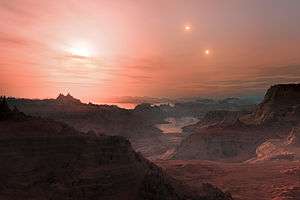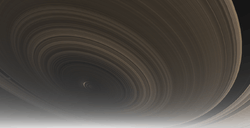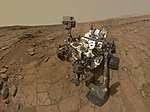Gliese 667 Cc
Gliese 667 Cc (also known as GJ 667Cc, HR 6426Cc, or HD 156384Cc)[3] is an exoplanet orbiting within the habitable zone of the red dwarf star Gliese 667 C, which is a member of the Gliese 667 triple star system, approximately 23.62 light-years (6.8 parsecs, or about 217,000,000,000,000 km) away in the constellation of Scorpius. The exoplanet was found by using the radial velocity method, from radial-velocity measurements via observation of Doppler shifts in the spectrum of the planet's parent star.
| Discovery | |
|---|---|
| Discovery date | 2011 (mentioned), 2012 (announced) |
| Radial velocity (European Southern Observatory) | |
| Orbital characteristics | |
| 0.1251 (± 0.03) AU | |
| Eccentricity | 0.133 (± 0.098) |
| 28.155 (± 0.017) d | |
| Inclination | >30 |
| Semi-amplitude | 1.5 |
| Star | Gliese 667C |
| Physical characteristics | |
Mean radius | 1.54+0.5 −0.4[1] R⊕ |
| Mass | 3.709 (± 0.682)[2] M⊕ |
| Temperature | 277.4 K (4.3 °C; 39.6 °F) |
Characteristics
Mass, radius and temperature
Gliese 667 Cc is a super-Earth, an exoplanet with a mass and radius greater than that of Earth, but smaller than that of the giant planets Uranus and Neptune. It is heavier than Earth with a minimum mass of about 3.7 Earth masses.[2] The equilibrium temperature of Gliese 667 Cc is estimated to be 277.4 K (4.3 °C; 39.6 °F).[1] It is expected to have a radius of around 1.5 R⊕, dependent upon its composition.
Host star
The planet orbits a red dwarf (M-type) star named Gliese 667 C, orbited by a total of two planets. The star is part of a trinary star system, with Gliese 667 A and B both being more massive than the smaller companion. Gilese 667 C has a mass of 0.31 M☉ and a radius of 0.42 R☉. It has a temperature of 3700 K, but its age is poorly constrained, estimates place it greater than 2 billion years old. In comparison, the Sun is 4.6 billion years old[4] and has a surface temperature of 5778 K.[5] This star is radiating only 1.4% of the Sun's luminosity from its outer atmosphere. It is known to have a system of two planets: claims have been made for up to seven, but these may be in error due to failure to account for correlated noise in the radial velocity data. Since red dwarfs emit little ultraviolet light, the planets likely receive minimal amounts of ultraviolet radiation.
Gliese 667 Cc is the second confirmed planet out from Gliese 667 C, orbiting along the middle of the habitable zone. From its surface, the star would have an angular diameter of 1.24 degrees and would appear to be 2.3 times[note 1] the visual diameter of our Sun as it appears from the surface of the Earth. Gliese 667 C would have a visual area 5.4 times greater than that of the Sun but would still only occupy 0.003 percent of Gliese 667 Cc's sky sphere or 0.006 percent of the visible sky when directly overhead.
The apparent magnitude of the star is 10.25, giving it an absolute magnitude of about 11.03. It is too dim to be seen from Earth with the naked eye, and even smaller telescopes cannot resolve it against the brighter light from Gliese 667 A and B.
Orbit
The orbit of Gliese 667Cc has a semi-major axis of 0.1251 astronomical units, making its year 28.155 Earth-days long. Based on its host star's bolometric luminosity, GJ 667 Cc would receive 90% of the light Earth does; however, a good part of that electromagnetic radiation would be in the invisible infrared part of the spectrum.
Habitability

Based on black body temperature calculation, GJ 667 Cc should absorb similar but slightly more overall electromagnetic radiation than Earth, making it a little bit warmer (277.4 K (4.3 °C; 39.6 °F)) and consequently placing it slightly closer to the "hot" inner edge of the habitable zone than Earth (254.3 K (−18.8 °C; −1.9 °F)).[6] According to PHL, Gliese 667 Cc is (as of July 2018) the fourth most Earth-like exoplanet located in the conservative habitable zone of its parent star.[7]
Its host star is a red dwarf, with about a third as much mass as the Sun. As a result, stars like Gliese 667 C have the ability to live up to 100–150 billion years, 10–15 times longer than the Sun will live.[8]
The planet is likely tidally locked, with one side of its hemisphere permanently facing towards the star, while the opposite side is shrouded in eternal darkness. However, between these two intense areas, there would be a sliver of habitability – called the terminator line, where the temperatures may be suitable (about 273 K (0 °C; 32 °F)) for liquid water to exist. Additionally, a much larger portion of the planet may be habitable if it supports a thick enough atmosphere to transfer heat to the side facing away from the star.
However, in a 2013 paper, it was revealed that Gliese 667 Cc is subject to tidal heating 300 times that of Earth. This in part is due to its small eccentric orbit around the host star. Because of this, the chances of habitability may be lower than originally estimated.[9][10]
Discovery
Gliese 667 Cc was first announced in a pre-print made public on 21 November 2011 by the European Southern Observatory's High Accuracy Radial Velocity Planet Searcher (HARPS) group using the radial velocity method (Doppler method).[11] The announcement of a refereed journal report came on 2 February 2012 by researchers at the University of Göttingen and the Carnegie Institution for Science and backing up the ESO HARPS group discovery.[12]
In fiction
Gliese 667 Cc features in the story "The Audience" by Sean McMullen in the June 2015 issue of Analog Science Fiction and Fact. In the Alien vs. Predator franchise, Gliese 667 Cc was the first planet to be terraformed, being done so by the Weyland Corporation in 2039. It is also mentioned in the 2015 novel Not Alone by Craig A. Falconer. This planet is also featured in Arkwright. Gliese 667 Cc is also the setting of the 2020 video game In Other Waters.
See also
| Wikimedia Commons has media related to Gliese 667 Cc. |
- KELT-4Ab, another exoplanet in a triple star system
- LTT 1445 is a triple M-dwarf system with one planet orbiting LTT 1445A
- List of potentially habitable exoplanets
References
- "The Habitable Exoplanets Catalog - Planetary Habitability Laboratory @ UPR Arecibo". phl.upr.edu.
- "GJ 667 C c". NASA Exoplanet Archive. Retrieved 2 August 2016.
- "HD 156384Cc". SIMBAD. Centre de données astronomiques de Strasbourg. Retrieved 2015-10-31.
- Fraser Cain (16 September 2008). "How Old is the Sun?". Universe Today. Retrieved 19 February 2011.
- Fraser Cain (15 September 2008). "Temperature of the Sun". Universe Today. Retrieved 19 February 2011.
- Anglada-Escudé, Guillem; et al. (2013-06-07). "A dynamically-packed planetary system around GJ 667C with three super-Earths in its habitable zone" (PDF). Astronomy & Astrophysics. 556: A126. arXiv:1306.6074. Bibcode:2013A&A...556A.126A. doi:10.1051/0004-6361/201321331. Archived from the original (PDF) on 2013-06-30. Retrieved 2013-06-25.
- "500 Internal Server Error". 9 January 2016.
- Adams, Fred C.; Laughlin, Gregory; Graves, Genevieve J. M. "Red Dwarfs and the End of the Main Sequence". Gravitational Collapse: From Massive Stars to Planets. Revista Mexicana de Astronomía y Astrofísica. pp. 46–49. Bibcode:2004RMxAC..22...46A.
- Makarov, Valeri V.; Berghea, Ciprian (2013). "Dynamical Evolution and Spin-Orbit Resonances of Potentially Habitable Exoplanets. The Case of Gj 667C". The Astrophysical Journal. 780 (2): 124. arXiv:1311.4831. doi:10.1088/0004-637X/780/2/124.
- http://www.centauri-dreams.org/?p=32470 See the GJ 667 Cc section.
- European Southern Observatory. Press information: The HARPS search for southern extra-solar planets. 11.24.2011.
- University of Göttingen. Presseinformation: Wissenschaftler entdecken möglicherweise bewohnbare Super-Erde - Göttinger Astrophysiker untersucht Planeten in 22 Lichtjahren Entfernung. Nr. 17/2012 - 02.02.2012. Announcement on university homepage, retrieved 2012-02-02
Notes
- . where is the apparent diameter of the star from the surface of the planet in orbit (GJ667Cc in this case), is the apparent diameter of the Sun (sol) from the surface of Earth, is the effective temperature of the Sun (sol), the effective temperature of the star, is the luminosity of the star as a fraction of the sun's luminosity and is the distance of the planet from the star in AU.
| Preceded by Gliese 581 g |
Highest ESI for an Exoplanet 2011–2015 |
Succeeded by Kepler-438b |


